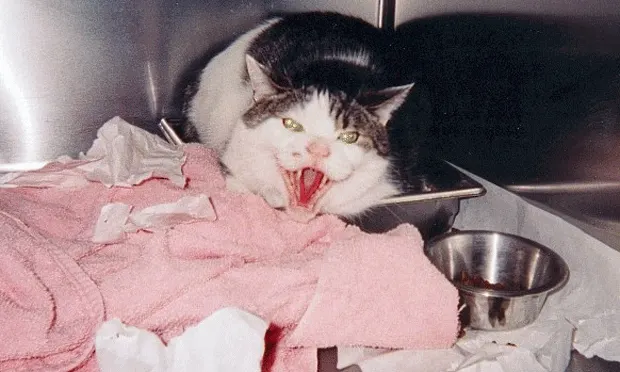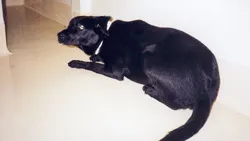Assessing Pain

What behaviors indicate pain in a pet?
The current standard of veterinary care requires that we address and implement pain management in our patients. While this sounds reasonable and appropriate, assessing pain in dogs and cats can be a challenge. The human medical field relies heavily on verbal communication to assess and treat pain, especially chronic pain conditions in which patients may show a muted pain response. Because our patients are nonverbal, clinicians must rely on other methods to judge pain and institute appropriate treatment. Several factors play into the decision to medicate for pain, including treating for predictable pain. In this article, subtle behavioral changes that may be associated with painful conditions will be discussed to help improve detection and treatment of pain in dogs and cats.
Above: Defensive-aggressive cat hissing. This cat, which is in postsurgical pain, is hissing to repel the approach of the kennel attendant.
PostureChanges in the pet's normal posture may indicate pain. Such postures include a hunched-up appearance, trembling, stiffening, or resting in a "praying" position with the forequarters on the ground and the hind end elevated. Low head carriage may indicate some level of discomfort or depression. Tail wagging in a dog is not indicative of a pain-free state-some dogs will still wag their tails in response to human attention despite moderate to severe pain.

Fearful dog cowering. This dog is exhibiting a painful posture by hunching and cowering from the approaching person.
Sleep PatternsInability to get comfortable or sleeping in an unusual posture for that pet may indicate pain.
A lack of dreams may be a subtle sign of pain, since dreams are indicative of rapid-eye-movement sleep, and patients in pain may not be able to achieve that state of deep sleep. To detect whether the pet is dreaming, one can look for rapid eye movement, which can sometimes be detected under the closed eyelids. Some pets will have involuntary movement of body parts (legs, mouth, whiskers) accompanied by some muted vocalization, such as a whimper.
VocalizationWhining, crying, howling, screaming, or barking may be associated with painful conditions, and animals that are exhibiting excessive or unusual vocalization should be examined for pain-related conditions. Other causes of excessive vocalization, such as anxiety, should also be considered and addressed, as increased anxiety may reduce pain thresholds. Aggressive vocalization, such as growling or hissing, can indicate pain and may be an attempt to repel stimuli that may inflict pain. Vocalizations that are traditionally associated with comfort (such as purring) are not necessarily indicative of a pain-free state. In fact, some cats that are in extreme pain or near death will purr. In general, younger animals are more prone to excessive vocalization when in pain. However, lack of vocalization can also be indicative of a painful state, especially in cats or older animals that are withdrawing from the environment.
GroomingA reduction or redirection of grooming activity can be an indication of pain. If the grooming is directed to a certain area of the body, such as an incision or a joint, this may be indicative of pain in that area. Cats that are ill or in pain often present with unkempt or greasy coat due to a lack of proper grooming.
ActivityA general decrease in activity (i.e., depression) or reduced exercise tolerance may be a sign of pain. Older animals tend to withdraw more than younger animals when they experience pain. Cats that lie quietly and do not move for prolonged periods may be in pain. Also, a reduced response to a caregiver could indicate a chronic or acute painful condition. Conversely, an increase in activity characterized as restlessness or agitation can be a sign of pain.
AppetiteReduction in appetite can be associated with many medical ailments but can also be a nonspecific sign of pain. Special consideration should be given to animals that are required to bend down (e.g., large dog eating from bowl on floor) or jump up (e.g., cat fed on counter) to access food.
EliminationPreviously reliable pets may start to house-soil due to painful conditions. This behavior may be related to pain associated with accessing acceptable elimination sites or actual pain associated with elimination. Of course, conditions that cause polyuria or diarrhea may cause house-soiling due to urgency issues.
ConclusionThese nonspecific signs of pain should be evaluated in relation to each other and in context of the situation. Clinicians can attempt to covertly observe their patients, as human interactions can override subtle signs of pain. Also, owner education can help owners to identify and report pain-related signs that the pet exhibits at home. During veterinary visits, owners should be prompted to discuss any behavioral changes in the pet, as such changes may be early indicators of pain or other medical conditions. Early identification of pain often results in greater treatment and management success.
TX at a glance...
Pain may present as subtle changes in
• Posture• Activity• Elimination• Appetite• Sleep patterns• Vocalization
ASSESSING PAIN • Jacqueline C. Neilson
Suggested Reading
Geriatrics: pain and its management. Sackman JE. Vet Clin North Am Small Anim Pract 27:1487-1505, 1997.Handbook of Veterinary Pain Management. Gaynor JS, Muir WW. St. Louis, MO: Mosby, 2002.Managing pain in cats, dogs, small mammals and birds: recognition, relief and economics. Proc NAVC/AAHA Annu Meet. Wilmington, DE: The Gloyd Group, 2003.Through a glass darkly: using behavior to assess pain. Hansen B. Semin _Vet Med Surg Small Anim_12:61-75, 1997.